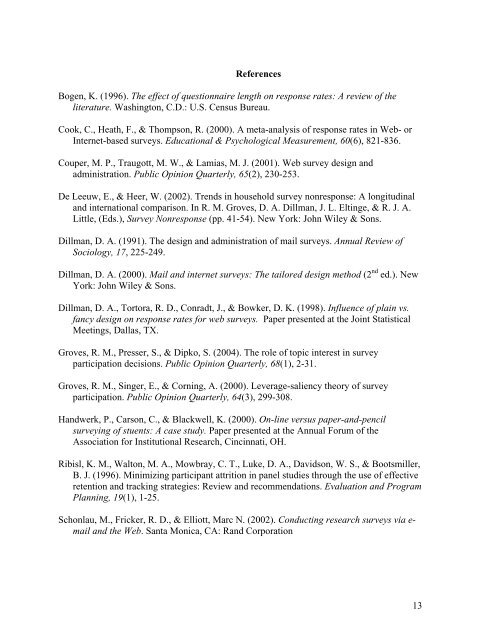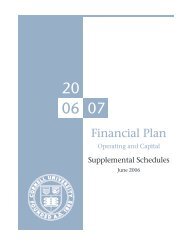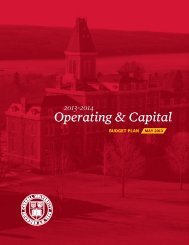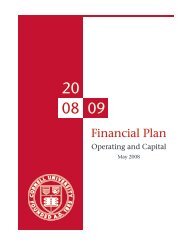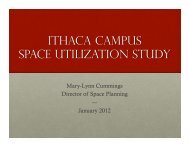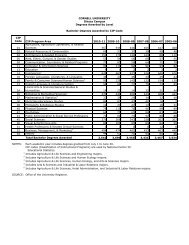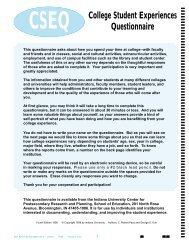Survey Design and Response Rates: - Cornell University Division of ...
Survey Design and Response Rates: - Cornell University Division of ...
Survey Design and Response Rates: - Cornell University Division of ...
Create successful ePaper yourself
Turn your PDF publications into a flip-book with our unique Google optimized e-Paper software.
References<br />
Bogen, K. (1996). The effect <strong>of</strong> questionnaire length on response rates: A review <strong>of</strong> the<br />
literature. Washington, C.D.: U.S. Census Bureau.<br />
Cook, C., Heath, F., & Thompson, R. (2000). A meta-analysis <strong>of</strong> response rates in Web- or<br />
Internet-based surveys. Educational & Psychological Measurement, 60(6), 821-836.<br />
Couper, M. P., Traugott, M. W., & Lamias, M. J. (2001). Web survey design <strong>and</strong><br />
administration. Public Opinion Quarterly, 65(2), 230-253.<br />
De Leeuw, E., & Heer, W. (2002). Trends in household survey nonresponse: A longitudinal<br />
<strong>and</strong> international comparison. In R. M. Groves, D. A. Dillman, J. L. Eltinge, & R. J. A.<br />
Little, (Eds.), <strong>Survey</strong> Nonresponse (pp. 41-54). New York: John Wiley & Sons.<br />
Dillman, D. A. (1991). The design <strong>and</strong> administration <strong>of</strong> mail surveys. Annual Review <strong>of</strong><br />
Sociology, 17, 225-249.<br />
Dillman, D. A. (2000). Mail <strong>and</strong> internet surveys: The tailored design method (2 nd ed.). New<br />
York: John Wiley & Sons.<br />
Dillman, D. A., Tortora, R. D., Conradt, J., & Bowker, D. K. (1998). Influence <strong>of</strong> plain vs.<br />
fancy design on response rates for web surveys. Paper presented at the Joint Statistical<br />
Meetings, Dallas, TX.<br />
Groves, R. M., Presser, S., & Dipko, S. (2004). The role <strong>of</strong> topic interest in survey<br />
participation decisions. Public Opinion Quarterly, 68(1), 2-31.<br />
Groves, R. M., Singer, E., & Corning, A. (2000). Leverage-saliency theory <strong>of</strong> survey<br />
participation. Public Opinion Quarterly, 64(3), 299-308.<br />
H<strong>and</strong>werk, P., Carson, C., & Blackwell, K. (2000). On-line versus paper-<strong>and</strong>-pencil<br />
surveying <strong>of</strong> stuents: A case study. Paper presented at the Annual Forum <strong>of</strong> the<br />
Association for Institutional Research, Cincinnati, OH.<br />
Ribisl, K. M., Walton, M. A., Mowbray, C. T., Luke, D. A., Davidson, W. S., & Bootsmiller,<br />
B. J. (1996). Minimizing participant attrition in panel studies through the use <strong>of</strong> effective<br />
retention <strong>and</strong> tracking strategies: Review <strong>and</strong> recommendations. Evaluation <strong>and</strong> Program<br />
Planning, 19(1), 1-25.<br />
Schonlau, M., Fricker, R. D., & Elliott, Marc N. (2002). Conducting research surveys via e-<br />
mail <strong>and</strong> the Web. Santa Monica, CA: R<strong>and</strong> Corporation<br />
13


